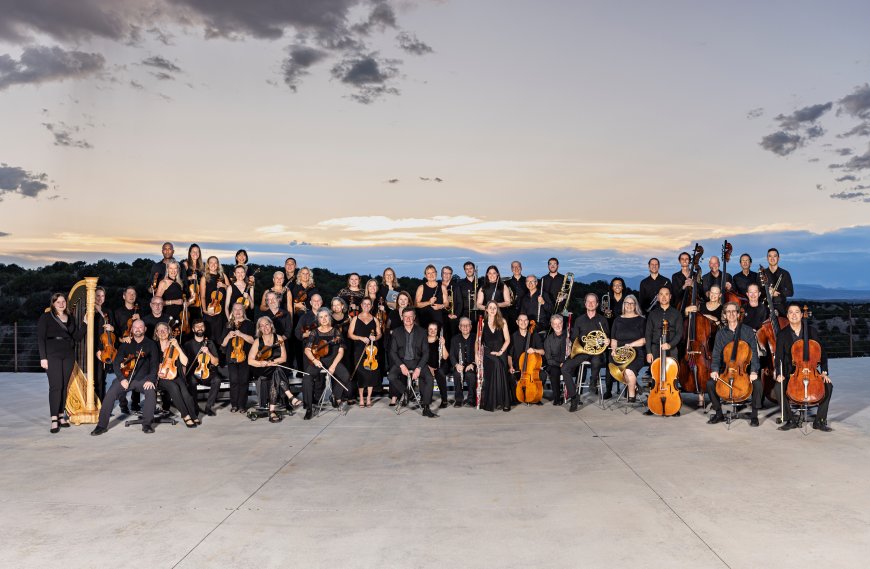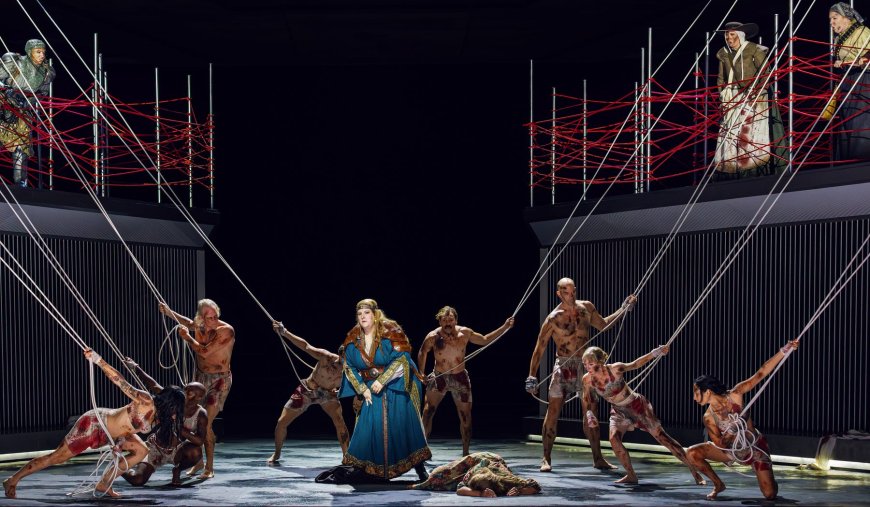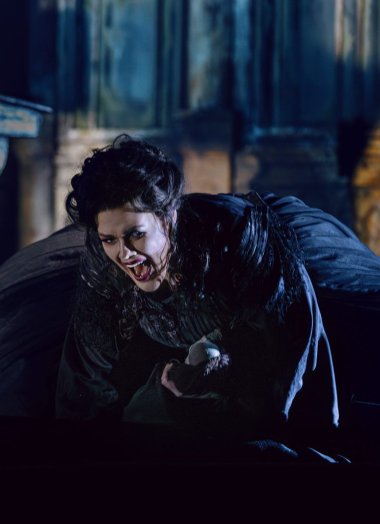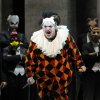
At Santa Fe Opera, the sunset starts the show. Perched on a hilltop with the back of the stage open to the purple vista of New Mexico's Jemez Mountains, the Crosby Theater reaches into infinite space. The distant western horizon becomes an additional character in the drama.
This spectacular natural setting confronts directors with unique opportunities and challenges: Performances start at 8 p.m., just as the sun begins its slow multi-colored descent, flooding the partially-covered auditorium with light. An hour later, the house and surroundings are plunged into darkness. Cooling (at times even cold) breezes flow across the orchestra seats from the open sides of the amphitheater.
Some nights, violent thunderstorms erupt— fatefully so. On Jul. 30, a cloudburst that besieged the theater during Santa Fe Opera’s production of Richard Wagner’s tempestuous Die Walküre could not have been better planned.
For many years, this company has presented passionate performances from some of the most talented singers around. During its 68th Festival season in July, longtime patrons said the programming was among the organization’s most artistic, successful, and varied.

I viewed three productions during Santa Fe’s 2025 season— Giuseppe Verdi's Rigoletto, Richard Wagner’s Die Walküre, and Benjamin Britten's The Turn of the Screw. Each opera handled the Crosby Theater’s challenges in different ways. In his Santa Fe Opera debut on Jul. 29, Director Julien Chavaz incorporated the view into the opening scenes of his dusty pink production of Rigoletto. Natural light flooded the stage and heightened the opulent Renaissance mood enhanced by multicolored lighting around the proscenium. Scenic Designer Jamie Vartan’s concept marked a refreshing departure from the gloomy stagings of Rigoletto that have been de rigueur in most opera houses. Yes, Rigoletto is a tragedy, but Vartan gave us something different — a Rigoletto lite.
After 34 Wagner-less years, SFO has staged three productions of Wagner operas over the last four seasons including Tristan and Isolde in 2022 and The Flying Dutchman in 2023. This year’s production of Die Walküre was an enormous achievement for the company — it was more than twice as long as the other productions and boasted an enormous orchestra and a cast double the typical size.

Also making her Santa Fe debut, director Melly Still opted to shut out the natural backdrop for her hermetic, provocative, and cerebral interpretation of Die Walküre. Scenic and costume designer Leslie Travers supported Still’s vision by creating a world enclosed by fences, ropes, and barriers, symbolizing the entanglements that bind and constrict the relations between mortals and gods in the second opera of Wagner’s tetralogy. The halves of the set opened and closed only occasionally to allow entrances and exits from the rear.
When Wotan, the king of the gods (bass-baritone Ryan Speedo Green, surrounded his wayward daughter Brünnhilde (veteran Wagnerian soprano Tamara Wilson with a protective ring of fire in the opera’s pyrotechnic finale, the scene took place at center stage around what looked like a backyard barbecue. Opening the stage to the post-midnight sky would have taken the action to the higher cosmic plane the music demands. Call me old-fashioned, but I was almost yearning for Otto Schenk’s traditional Met production, with its humble huts, open skies and fairytale atmosphere. Still’s production was an inside-baseball Die Walküre for the cognoscenti.

For devoted Wagnerians, the stellar cast was a dream come true. Green dominated the stage as Wotan, singing with clarion intensity and lyricism, and radiating power and paternal wisdom. Few singer-actors could have so convincingly pulled off his striking (and here, entirely appropriate) bare-chested appearance in Act III.
Wilson illuminated her character’s complicated relationship with a well-meaning but controlling father through stunning changes in phrasing, volume, and demeanor— a portrayal that matched Green’s in power, presence, and artistry. The pairing of these two epic voices kept us riveted to the end despite the damp chill and very late hour (12:45 a.m.). She illuminated her complicated emotional relationship with a well-meaning but controlling father through stunning changes in phrasing, volume, and demeanor.
The acoustics at SFO don't favor the orchestra. Under conductor James Gaffigan, the orchestra provided sensitive accompaniment for the singers but sounded underpowered at times, with some tentative playing from the soloists.

Four cast members made their Santa Fe Opera debuts, including fast-rising Lithuanian-born soprano Vida Miknevičiūtė, and American singers were well-represented in the cast. Fast-rising Lithuanian Vida Miknevičiūtė made abused housewife Sieglinde a deeply sympathetic character, cowering by the refrigerator in a shabby 1950s kitchen. Her voice is a marvel, rich, expressive, and full of pathos and awakening love.
As Sieglinde’s crude husband Hunding, bass Soloman Howard sang with carefully controlled musicality. Tenor Jamez McCorkle was a tender Siegmund, and Sarah Saturnino’s gleaming mezzo made Wotan’s nagging wife Fricka into a more appealing and engaging character than she often appears.
In The Turn of the Screw, Britten's disquieting interpretation of Henry James’s psychological ghost story of the same name, the haunted gardens cry out for an al fresco treatment. Santa Fe delivered just that during its Aug. 1 performance.

As the sun set, the shift from light to dark “turned the screw” of the Governess’s journey from sanity to madness. Director Louisa Muller and designer Christopher Oram used tall, swiveling Palladian glass doors that opened and closed to the natural light and dark, through which the Governess (appropriately frenzied soprano Jacquelyn Stucker) viewed the shadowy comings and goings of her dead tormentors. Surprisingly, Muller did not amplify voices from the wings to represent the ghosts’ pleadings. Instead, in Muller’s interpretation, the Governess sees visitors from the beyond as real beings singing (loudly) right in front of her.
The cast of The Turn of the Screw also included Wendy Bryn Harmer as the deceased Miss Jessel. She employed the same powerful soprano voice she uses for demanding Wagner roles like Helmwige in Die Walküre. Boy soprano Everett Baumgarten sang sweetly as Miles. Annie Blitz sang more forcefully so as his sister, Flora. American tenor Brenton Ryan made an appropriately sinister Peter Quint, former valet to the master of the house,. The ensemble sections toward the opera’s climax where Miles dies in the Governess’s arms brought shivers.

Gemma New, another newcomer to the company, conducted the chamber-sized orchestra in a meticulous and inspired performance of Britten’s challenging score. As in all of Britten’s operas, the instrumental ensemble provides essential commentary on the drama. Principal percussionist Robert Klieger employed an entire battery of instruments, including glockenspiel, tubular bells, various drums, and a gong, with subtle artistry to create a spooky, off-center atmosphere.
Rigoletto, like Die Walküre, tells another story of a dominating father and a wayward daughter. Since its premiere, in Venice in 1851, Verdi’s violent and stormy melodrama has never gone out of style.
Director Julien Chavaz stressed the opera's comic elements, weird though they may be. The design featured rich tapestry and brocade inspired by Renaissance art which covered the walls in deep pink and burgundy. Movement director Nicole Morel went overboard with choreography resembling revels at the Folies Bergère, complete with can-cans on the beat.
When the unfortunate Gilda (soprano Elena Villalón), Rigoletto’s daughter, confesses she has been raped by the amoral and lascivious Duke of Mantua (Duke Kim), the bulbs framing the proscenium went from white to scarlet, symbolizing his fury for vengeance. Small lamps and candles proliferated around the stage.
Michael Chioldi had recently sung the role of Rigoletto at Irish National Opera and came well-prepared. He understood the sad court jester to his tortured core from his first entrance, and brought the required passion and vocal chops. Burly and imposing, he towered over the rest of the cast both vocally and dramatically.
Kim played Rigoletto’s nemesis, the sexual predator Duke, as a slight and rarely menacing dude. A light lyrical tenor, he rushed many of his big arias, including the Act III showpiece “La donna è mobile.” Villalón’s heavy voice sounds mature for the teenaged Gilda and the coloratura style, and her high notes did not always soar. She revived, however, for her final duet with Chioldi, staged in conventional I-can-still-sing-although-I-am-dying style.
Bass Stephano Park made a rather understated and mild-mannered Sparafucile, but mezzo-soprano Marcela Rahal, in her Santa Fe debut, took no prisoners as Maddalena, his flamboyant sister and co-conspirator. Chinese bass-baritone Le Bu made Monterone’s curse a vocal highlight, with strong, clear delivery and enunciation.

Every performance at Santa Fe Opera feels like a special event. The surroundings elevate the experience literally and figuratively. Judging by these three thoughtful and lavish productions, this season was no exception. The company’s artistic standards continue to rise, attracting the world's top operatic talent despite the challenge of working and singing at an altitude of 7,000 feet.
For those dwelling at sea level like me, merely breathing takes extra effort. Perhaps the company’s productions quite literally take your breath away. It’s a good thing I didn't have to sing.




